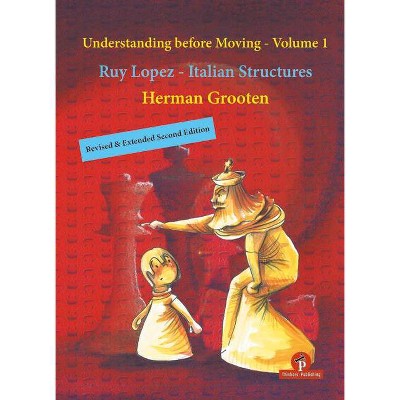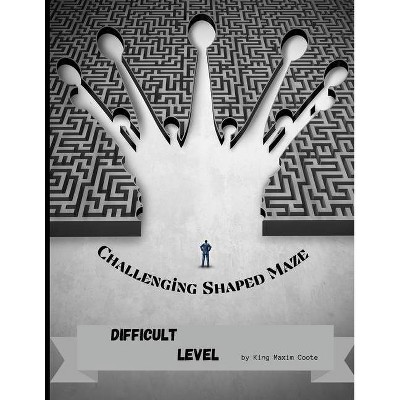Understanding Before Moving 3 - Part 2 - by Grooten (Paperback)

Similar Products
Products of same category from the store
AllProduct info
<p/><br></br><p><b> Book Synopsis </b></p></br></br>Before you lies the second volume in a trilogy about the Sicilian Defense. The first volume dealt with the Najdorf and Scheveningen variations, and it is now time to pay attention to three other extremely popular systems: the Taimanov, Kan and Richter-Rauzer variations. After careful consideration within the Thinkers Publis-hing team, we decided that it made sense to group these variations together. In particular, the first two are closely related and share the feature that, in both cases, Black plays <strong>...e7-e6</strong> and <strong>...a7-a6</strong> at an early stage. They typically have the idea of retaining more options for their king's bishop by postponing <strong>...d7-d6</strong> (or even omitting it entirely.) The bishop may go to b4 or c5 in different lines. The Richter-Rauzer is, in theory, just one of the possible developments from a Classical Sicilian. We have already dealt with a few games that started with the Classical and where Black shortly played <strong>...e7-e6</strong>; and <strong>6.</strong>B<strong>c4</strong> (the Sozin variation) was rightly treated within the Scheveningen pages. However, it is clear that White's most popular counter, the Richter-Rauzer variation (<strong>6.</strong>B<strong>g5</strong>) deserves separate attention. While looking at the variation structure for the Kan and Taimanov and deciding on which model games to use, I noticed a lot of possible transitions to the 'Hedgehog' structure, shown on the right. The key features are white pawns on e4 and c4, and at least four black pawns on a6, b6, d6 and e6. This structure is ideally suited to the task of playing for a win as Black, because of the very complicated middlegames that arise. (And one often needs complicated middlegames to have a better chance of 'converting' a rating advantage!) The 'Hedgehog' is definitely a structure rather than a variation, but it has such a distinctive character of its own that I chose to examine it first in chapter 2. This simplifies later discussion of the Taimanov and Kan variations by removing the need to discuss every possible way of entering a Hedgehog structure.</p><p/><br></br><p><b> Review Quotes </b></p></br></br><br>The highly experienced Dutch coach and IM continues his detailed series for Thinkers Publishing, here looking at the Taimanov, Kan and Classical - Richter Rauzer variations of the Sicilian. There is also a very welcome chapter on the Hedgehog structure, Grooten's clear style, the many-arrowed diagrams and the fine choice of illustrative games should enable the hard-working club player to quickly further their understanding of these very important Sicilian lines and typical positions.</p> Chess, April issue 2021.</p><br><br>, <em>Understanding Before Moving 3: Sicilian Structures Part v2 - Taimanov, Kan and Richter Rauzer, </em>is aimed at a somewhat different audience, here the aim is squarely club players ranging from 1800-2300. </p> This well written book, the second in a series on the Sicilian by the Dutch International Master Herman Grooten, aims to explain the typical plans for White and Black in the Taimanov (1.e4 c5 2.Nf3 e6 3.d4 cxd4 4.Nxd4 Nc6), Kan (1.e4 c5 2.Nf3 e6 3.d4 cxd4 4.Nxd4 a6) and Richter-Rauzer (1.e4 c5 2.Nf3 Nc6 3.d4 cxd4 4.Nxd4 Nf6 5.Nc3 Nc6 6.Bg5). </p> Coming in at a massive 421 pages, this book does not cut corners. Grooten offers an overview of each variation followed by model games which are well annotated throughout. Club players looking to learn how to play or play against the Sicilian will find this book most helpful, particularly players below 2000. Rather than start out trying to memorize a bunch of sharp theory they will do much better to build a solid foundation by first learning the typical plans and ideas are for both sides.</p> IM John Donaldson - April 2021.<br><br>The book, Understanding before Moving Volume 3 - Part 1, sets out to enable the reader to learn two variations of the Sicilian by placing maximum emphasis on understanding, but succeeds in accomplishing significantly more. Reading the book offers a chance to improve your ability to study opening variations and chess as a whole. And best of all, you will understand why this is so. Highly recommended. Paul Hopwood - Chess - April 2020.<br>
Price History
Cheapest price in the interval: 31.49 on October 22, 2021
Most expensive price in the interval: 31.49 on November 8, 2021
Price Archive shows prices from various stores, lets you see history and find the cheapest. There is no actual sale on the website. For all support, inquiry and suggestion messagescommunication@pricearchive.us




















